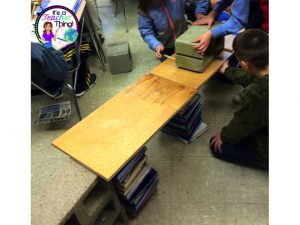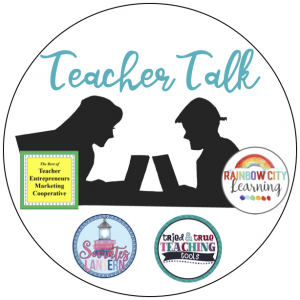
Challenging teaching days…UG! As teachers, we all know that coming back from long vacation breaks (like a 2-week winter break) can be some of the most difficult times of the year to teach. Many students have gotten out of the school routine. I have a few tips to help you through those challenging teaching days and weeks.
1. Encourage positive behavior
Do something unique to encourage positive behavior for the challenging teaching days and weeks after a break.
Create special “tickets” to hand students when they’re on task, doing what is asked. Have students write their names on the tickets and collect them. I have a container that sits out so students can deposit tickets when instruction isn’t interrupted.
Find a few unique items to set aside as prizes. I create homework passes (see the freebie link at the end of this post) and I offer a book pick from the book order. I also may go find some holiday-themed items for the coming month. Once each week (or more if required) collect the tickets. Pull out the prizes. Draw a select number of tickets. Do this again the next week. This is one way to encourage positive behavior during challenging weeks of teaching.
2. Be more flexible on those difficult teaching days
Things aren’t always perfect.
You may have your lessons all planned out to perfection, but there may be days when things just don’t go as planned. Don’t fight it. Notice the general feel of the class. Does it seem like your lesson will make an impact, or is it something to save for a time when there’s more student focus? Allow yourself flexibility in your curriculum. You can’t force learning. Just because you teach something doesn’t mean your students will learn it.
Always have a back-up plan. It may be the perfect time to start an engaging read aloud. I love reading The Watsons Go to Birmingham after winter break. It’s highly engaging and leads to great teaching moments.
If I can engage students back into the learning environment, then I consider it a success. Additionally, I love having things like Color-By-Code resources available. There are times when just sitting and coloring is what students can handle. If the color-by-code pages are academic in nature, then students are working. Find a selection of seasonal color by code grammar pages here and color by code multiplication pages here.

3. Pull out a great activity on difficult days in the classroom.
Save your most engaging activities.
Use hands-on activities where students can work in partners or small groups to accomplish a task. For example, since I teach about ancient Egypt, I have an activity that simulates the building of the Great Pyramid. It’s simple: I have cinder blocks (yes, I keep them in a cabinet all year long), wooden dowels (or old pencils), string, and wooden blocks and wedges (from my daughter’s old block set, but your local hardware store is a great resource for bits of wood).
I ask students to figure out how to move a cinder block from one side of the classroom to the other. They must plan it out before touching any materials. AND, they can not lift the block. Talk about FOCUS!

Students figure out that the longer the ramp, the lower the incline.
These are just a few ideas. You may have something that will fit into one of these examples. The main thing is that students are engaged!
4. Do something different.
Do something totally unique that students find engaging.
I like to do book clubs after long breaks. Book clubs are different and require student focus because they are holding one another responsible for the work required to complete the reading and discussion pages for the upcoming book club meeting.
I invite in local people from the area to participate in book clubs with my students. This adds another layer of accountability and uniqueness. I get a very high engagement rate when I use book clubs, plus once I’ve created the packets and organized the meetings, my work is mostly done for three weeks! Read more about book clubs here.
5. Keep it engaging.
Save your best high-interest academic activity for challenging teaching days
I have a favorite story from my literature anthology that I like to save for those tough weeks of teaching. Kids love the story, and there are numerous activities we can do with it.
• I copy several pages of the story and we practice text annotation
focused on the two main characters.
• We role play and defend the characters’ positions
• We look at the figurative language in the story and I pull out a
set of figurative language task cards that go along with the
season. (find them here)
• I may do the close reading Oreo lesson I wrote about in an earlier
blog post that you can find here to teach the importance of close reading.
• Kids really enjoy debating who’s to blame for the problem that
arises.
• AND…there’s a 30 minute video that goes along with the text,
which I save for Friday. We build anticipation all week as to what
the visual interpretation of the story will be like, then we
compare and contrast the two.
Once you’ve got them hooked on learning again, teaching becomes a lot easier. The more you plan either before the break or during the break, the better results you’ll have. Reducing stress is a high priority on my list, so I tend to sketch out plans and have things set up for when we walk into the classroom after a vacation break.
Here’s a freebie: Winter Homework Passes

Use them as part of your special Positive Behavior Drawings. I’d love to hear some of your best teaching tips for returning from a vacation break.
I’m teaming up with some fabulous bloggers. Check out their posts.




Marcy, I love this post. We all know what those challenging teaching days are like, esp around the holidays. Your ideas are right on. I especially like handing out tickets when kids are on target. Have a wonderful holiday.
I love the idea of book clubs in the classroom.
Marcy, I used to teach ancient Egypt when I was a sixth grade teacher. My students would have loved the Great Pyramid lesson!!